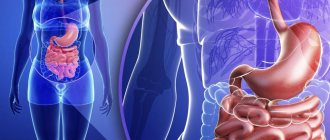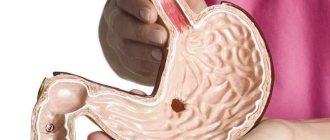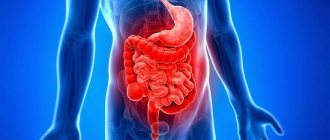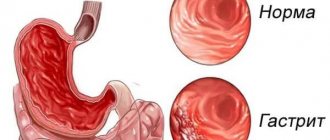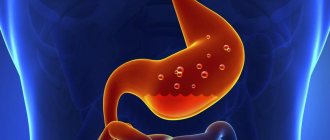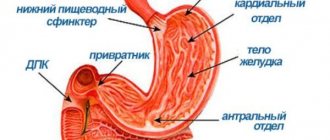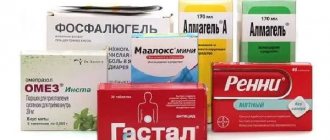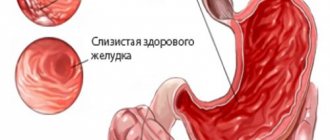The concept of gastritis
Gastritis comes in different types and forms.
According to the nature of their course, they can be acute or chronic. One of the varieties of a protracted process is considered to be erythematous gastritis. Erythematous gastritis is a disease of the epithelial lining of the stomach with small, most often bright red rashes in the form of ulcers. As a rule, the lesion occurs in the lower part of the organ, which, in addition to its motor role, performs the function of reducing acidity during the transition of food chyme into the duodenum. With this type of gastritis, inflammatory changes are superficial, but despite this, the disease can quickly progress to another form of the disease and cause serious complications.
Erythematous gastritis quickly develops into more dangerous forms
Treatment and diet
If erythematous gastritis is diagnosed, drug treatment is prescribed along with diet. Depending on what type of disease has been identified and in what form it occurs—acute or chronic—a complex of appropriate medications is prescribed. The patient must give up bad habits, as well as foods that irritate the gastric mucosa. You should absolutely not use:
- spicy, fried, fatty foods;
- spices, smoked meats, highly salted foods;
- strong tea, coffee, alcohol, carbonated drinks;
- products containing dyes and other unnatural substances.
In addition to all of the above, depending on the severity of the disease and acidity, many products may be prohibited, such as milk, meat, legumes, and baked goods.
It is preferable to consume it warm. Eating too hot or cold irritates the gastric mucosa, as does smoking, which should also be stopped. It is recommended to eat split meals, in small portions 5-6 times a day. The duration of the diet and the entire course of treatment will depend on the degree of advanced disease.
Causes
Like any other diseases associated with stomach problems, erythematous gastritis is provoked by one or several factors, depending on existing diseases and lifestyle.
In order for treatment to be competent and timely, you should know about the causes of the disease:
- stressful situations;
- uncontrolled use of hormones and antibiotics;
- poor nutrition;
- bacterial or viral infections;
- hereditary predisposition.
How to identify the disease
In order to correctly prescribe treatment for gastritis, it is necessary to conduct a timely diagnostic study. It helps to assess the condition of the mucous membrane, establish the cause of the pathology, its severity and possible consequences.
To identify erythematous exudative gastritis, the following methods are used:
- Ultrasound examination - helps to detect pathology, see the condition of the stomach walls, the presence of erosions.
- Fibroesophagogastroscopy.
- Clinical examination methods - each patient is prescribed a blood and stool test.
- Endoscopic examination is characterized by the insertion of a probe into the cavity of an organ, with the help of which a medical specialist obtains information about the condition of the organ, its mucous membrane, the presence of damage, and the area of injury. You can see redness, areas of inflammatory processes and much more.
In addition to the listed diagnostic methods, magnetic resonance imaging can be used as a supplement, and gastric pH tests are performed.
Based on the results of an instrumental examination, external examination of the patient, and palpation of the stomach, the doctor determines the diagnosis and prescribes a course of therapy depending on the stage of the pathology, type, and age of the person.
Etiology of occurrence
To get rid of erythematous gastropathy (gastroduodenopathy), it is necessary to identify and eliminate the damaging factor that caused it. The occurrence of this pathology is provoked by the following reasons:
- poor nutrition: excessive consumption of spicy, fried, salty, smoked foods, abuse of fast food, carbonated drinks, etc. ATTENTION! Eating such food before the FGDS procedure provokes the appearance of foci of hyperemia on the endoscopic picture;
- taking certain types of medications that affect the condition of the digestive tract mucosa (NSAIDs, glucocorticosteroids, antibiotics, anticoagulants, etc.);
- infectious factor. The development of this gastropathy is promoted by certain bacteria, in particular Helicobacter pylori, and fungal pathogens;
- reflux of bile into the stomach, exposure to hydrochloric acid during long intervals between meals;
- stress factors: anxiety, lack of sleep, nervous and physical overload;
- bad habits: smoking, alcoholism;
- hormonal dysfunction and metabolic disorders;
- congestion in the digestive tract;
- hereditary factor;
- concomitant diseases can trigger the etiological mechanism for the appearance of gastropathy (pancreatitis, cholecystitis, enteritis, etc.);
- ischemic manifestations in the gastric wall;
- food and drug allergies.
Recommendations for patients with erythematous gastritis
If a person has managed to achieve stable remission from gastritis, then he must constantly adhere to some recommendations. They will be useful to all people who are not faced with the disease:
- proper nutrition - healthy, fresh foods, optimal cooking temperature, no overeating;
- exclusion from the menu of unhealthy foods that are prohibited for gastritis;
- mandatory consumption of vegetables every day;
- moderate physical activity;
- giving up bad habits - smoking and alcohol;
- regular visits to the doctor to identify hidden sources of infection and inflammation, as well as their timely treatment;
- control of medication consumption;
- ability to cope with stress, alternating work and rest schedules.
Erythematous pangastritis and its other forms can be treated with proper effort. If you do not ignore the symptoms, visit your doctor on time and follow his instructions, you can forget about gastritis for a long time.
source
Symptoms
The signs of erythematous gastritis are usually identical to other types of the disease and even gastric ulcers. However, you need to know them and at the first manifestations you should consult a doctor.
From the patient's point of view, these are:
- causeless loss of appetite;
- there is pain and burning in the stomach during or after eating;
- symptoms of stomach dyspepsia: nausea, belching and heartburn;
- signs of stool disorder.
Symptoms of pangastritis
The disease has a slow chronic course, so patients often ignore the early symptoms of gastritis. In the early stages, the disease is characterized by the appearance of discomfort in the upper abdomen associated with eating.
Later symptoms of the disease include:
- general weakness, headaches and dizziness;
- decreased appetite;
- heartburn
; - the appearance of flatulence
; - severe pallor;
- sour taste in the mouth.
Symptoms of pangastritis persist for a long period of time. If a patient constantly feels symptoms of stomach damage, then he should consult a doctor and be examined for gastritis.
Kinds
Pangastritis (or diffuse form) - the entire surface of the mucous membrane is affected; Focal superficial gastritis - a person feels pain in a specific spot. Inflammation covers several foci; Antrum gastritis – the antrum of the stomach is affected (that is, the place of transition to the duodenum);
It is important to note that for any form of erythematous inflammation, patients are contraindicated in consuming chocolate, coffee, soda and alcohol. In order to quickly overcome exudative gastritis, you should give up bad habits and reduce the occurrence of stressful situations.
In case of severe exacerbations of erythematous disease, hospitalization and taking medications prescribed by the attending physician are indicated. Do not buy medications without his advice. There is also a treatment for erythematous exudative gastritis using traditional methods, which must be combined with a limited diet. The first thing you need to do is take infusions or decoctions of herbs during meals.
An effective method of control is considered to be white cabbage juice, which should be drunk warm 2 times a day when the acidity of the stomach is low. And for high acidity, an infusion of birch bark is recommended.
Gastritis of the antrum is characterized by damage to the antrum, where the stomach passes into the duodenum
Gastritis of the antrum is characterized by damage to the antrum, where the stomach passes into the duodenum. In the absence of proper treatment, the type of disease can quickly develop into a stomach ulcer. The antrum of the stomach is necessary to normalize the acidic environment in the hollow organ. When inflammation of the mentioned area occurs, the movement of stomach contents slows down, undigested food stagnates, and fermentation processes begin.
Erythematous exudative gastritis with damage to the antrum does not affect the deep layers of the epithelium, only its surface. Red spots on the walls of the stomach are the result of dilation of blood vessels, which occurs as a reaction of the body to the occurrence of inflammation. The process, when pronounced, leads to bleeding.
Depending on the manifestation of the disease, erythematous gastritis is of several types:
- superficial erythematous gastritis is considered to be the initial stage, which without proper treatment can aggravate the condition and progress to a more serious stage of development. The lining surface of the gastric mucosa becomes inflamed and begins to change;
- focal gastritis is characterized by point manifestations of inflammation in various parts of the digestive organ. If the lesion occurs in the antrum of the stomach, then if left untreated, peptic ulcer disease is possible. This area is adjacent to the duodenum and maintains a normal acidic environment. Antral gastritis slows down the functions of this section and causes stagnation and fermentation of undigested food;
- Erythematous exudative gastritis is characterized by damage to the entire mucous membrane of the organ or most of it. The disease can be caused by parasites or foreign food proteins that cause allergic reactions. The disease develops against the background of the presence of superficial and atrophic gastritis. The second name for this type of disease is eosinophilic gastritis. It is named so due to the accumulation of eosinophils on the mucous membrane, which should not be there at all;
- Pangastritis is the most advanced form, characterized by total damage to the entire area of the stomach.
Features of the course of the disease
Superficial gastritis, when the inflammatory process affects only the upper layers of the gastric mucosa, is only one form of the disease. The second common form is atrophic, when glandular atrophy occurs. These concepts were introduced into circulation in 1948 by the German surgeon Schindler, after analyzing the results of an endoscopic examination of the gastric mucosa.
Red or pinkish spots that appear on the surface of the gastric mucosa are the result of dilation of blood vessels due to inflammation. The inflammatory process starts on the surface of the mucous membrane in places where there is no protective layer.
If red spots are localized on the mucous membrane of the organ in the form of islands, they speak of a focal form of erythematous exudative gastritis.
More often, the disease makes itself felt in the second form - diffuse, when the inflammatory process covers most of the surface of the mucous membrane, including the antrum (pyloric region), connecting the stomach with the duodenum. If the membrane is completely affected, pangastritis is diagnosed.
How to treat incipient erythematous gastritis
Any treatment for the stomach begins with the correct selection of diet. In the acute stage of the disease, spices, fried, fatty, and baked foods must be excluded from the diet. Food should be light and simple in texture. Method of preparation: steamed or boiled only. Before eating, you need to grind the food with a blender or grater.
For erythematous gastritis, all dishes should be chopped before consumption
The diet should contain a sufficient amount of protein and easily digestible fiber. Breakfast should start with enveloping porridges and jelly. After the acute period has passed, you can add stewed vegetables or casseroles, light salads, omelettes, and a little salt and sugar for spices. It will be useful to drink fermented milk drinks, especially 2-3 hours before bedtime.
Taking medications is a necessary condition for restoring the gastric mucosa. Treatment should begin with eliminating the cause of gastritis. The doctor may prescribe antibacterial drugs if gastritis is caused by Helicobacter bacillus - Trichopolum, Amoxicillin. Stomach-coating drugs - Vikalin, De-nol - must be prescribed.
Based on the results of determining the acidity of gastric juice, agents are selected that increase or decrease the production of hydrochloric acid. Enzymes that help proper digestion, antispasmodics, painkillers, antiemetics, sedatives are also prescribed depending on the severity of the disease.
Drugs for the treatment of erythematous gastritis are selected depending on the symptoms
Along with medications, it is advisable to use traditional medicine methods:
- in pharmacies you can purchase a gastric mixture with a complex of herbs that have a positive effect on the condition of the mucous membrane;
- Taking Kyzyl May oil on an empty stomach has a good effect; it has a wound-healing effect, softens the lining of the stomach, relieves inflammation and pain;
- a decoction of flax seeds also creates a protective film in the stomach, relieves swelling and inflammation;
- White cabbage juice or freshly squeezed potato juice help with stomach diseases.
But even traditional medicine can have a negative effect on the body if the treatment prescription is chosen incorrectly. Before starting to take herbs or juice, you should consult your doctor. Treatment is selected only by a gastroenterologist, taking into account the diagnosis, complaints and individual characteristics of the person. Your health depends only on how quickly you seek qualified help.
How should you eat?
In order for drug therapy to bring the expected result, each patient must follow a strict diet during the treatment process.
This category of patients must adhere to the following recommendations:
- You need to completely exclude all harmful foods from your diet, in particular fast food, sweet soda, coffee, as well as smoked foods, pickles, fatty, spicy and fried foods. All kinds of dressings and spices are also prohibited.
- To reduce the load on the stomach, the patient should eat small portions. The number of meals should reach 5-6 per day.
- It is prohibited to consume foods that have not undergone heat treatment, as well as hot dishes. Too cold food should not be present in the diet.
- In the process of preparing dishes, technologies such as boiling, baking, and stewing should be used. The ideal option would be food cooked in a double boiler.
- Patients diagnosed with erytomatous form of gastritis should give up bad habits forever. If they cannot quit smoking, then the daily number of cigarettes should be limited, and in no case should this be done on an empty stomach.
- During the day, the patient can drink still mineral water, herbal infusions, weak teas, compotes, fruit drinks and juices prepared with his own hands.
- The patient's daily diet must be balanced. The last meal should be no later than 3 hours before bedtime.
Which doctors should I contact?
If symptoms of erythematous gastritis are detected, you should seek help as soon as possible in order to prevent the development of further complications. As with any other stomach disease, a therapist and gastroenterologist will help you cope with the problem.
However, in the treatment of this particular type of gastritis, a visit to a nutritionist will be especially important, since the basis of treatment is a properly selected diet.
Erythematous gastritis is a common pathology of the digestive system, in which an inflammatory process or erosion begins on the gastric mucosa with characteristic spots. Translated from Greek, the word “erythema” means “redness”. In this case, patients do not experience damage to the deep layers of the stomach.
Most often, the pathological process affects the lower part of the organ, which is called the antrum. It is in this area that the exit to the duodenum is located. The main task of the antrum is to lower the acidity level of digested food before it enters the intestines.
To find out what erythematous gastritis is, you need to understand the causes of its occurrence and symptomatic manifestations. Only after establishing the cause of the disease, specialists determine further treatment.
Signs of pathology
All the signs of the disease, which will be discussed below, can also appear in other pathologies of the digestive system. Highlight:
- frequent heartburn;
- pain in the stomach area, feelings of heaviness and discomfort that appear after each meal;
- nausea after eating food;
- burning sensation on an empty stomach;
- decreased or complete lack of appetite;
- belching with an unpleasant aftertaste and a thick coating on the tongue;
- frequent intestinal disorders;
- state of weakness and weight loss;
- fatigue and irritability;
- slight increase in body temperature.
Characteristic symptoms
Dangerous signs indicating the onset and progression of the disease are often missed, since digestive disorders such as heartburn and stomach pain are often associated with poor diet and stress.
The patient is confident that as soon as the stressful situation stops, the digestive process will return to normal. But more often it happens that such a provoking factor makes itself felt not for the first time. And in combination with a hereditary factor, pathological changes in the organ manage to reach a stage where it is no longer possible to do without a course of treatment.
That is why the following symptoms should not be ignored and they should be a reason to visit a gastroenterologist and undergo a medical examination.
Schedule a visit to your doctor if:
- Began to experience heartburn frequently;
- A burning sensation occurs even when the stomach is empty;
- You notice rapid fatigue;
- Worried about irritability and mood swings;
- A white coating appeared on the surface of the tongue;
- Belching occurs, leaving a pronounced unpleasant aftertaste;
- After eating there is a strong feeling of fullness and heaviness;
- Body temperature rises slightly but regularly;
- Completely lost or very weak appetite.
What complications can there be?
If a person seeks medical help in time, the consequences can be prevented. Any inflammatory process, under the influence of negative factors, will only develop intensively. Inflammation of the gastric mucosa is fraught with ulcerative lesions. The sores may open over time. Against this background, peritonitis and sepsis develop. A very common consequence of inflammation is gastric bleeding. Such complications are extremely life-threatening. One of the complications of gastritis is stomach cancer.
Under no circumstances should you self-medicate and think that your stomach will hurt and stop. At the first symptoms, you should immediately undergo an examination. In this case, the positive result from the therapy completed is 99%.
Normally, the inside of the stomach is covered with a thin pink membrane. The mucous membrane protects the organ from the effects of acid produced by the digestive glands, as well as from the components of the bolus of food entering the stomach. When exposed to certain factors, the mucous membrane loses its integrity and resistance to irritants. The process of inflammation begins in it and a disease such as gastritis develops.
Erythematous gastritis comes in several forms, which differ in the severity of symptoms
Principles of treatment
If erythematous gastritis has been accurately diagnosed, the average person does not know what to do next. In this case, it is impossible to do without qualified medical care. Moreover, this type of gastritis is effectively treated only at the initial stage of development.
It is for this reason that the importance of early diagnosis was noted above.
For erythematous gastritis, treatment will always include proper nutrition. This is what will put the gastric mucosa in order and prevent further development of the pathological process. The diet of a patient suffering from erythematous gastritis should include foods that do not irritate the mucous membrane of the walls of the digestive organ.
In this case, the therapeutic diet for the patient is prepared taking into account the level of acidity. So, in case of high acidity, experts recommend consuming foods only warm, excluding from the menu:
- fatty foods and saltiness;
- broths;
- smoked meats;
- fresh baked goods.
If the acidity level is low, it is necessary to exclude foods rich in fiber from the diet and reduce the consumption of smoked meats, marinades, onions and garlic.
If a chronic form of the indicated pathology has developed, then you should be prepared for the fact that the course of therapy will be long. In these circumstances, the patient is prescribed special medications that allow the areas of the stomach damaged by gastritis to be restored. And self-medication in this case is absolutely excluded.
The choice of medications will depend on what caused the inflammatory process. If we are talking about an infection, then antibacterial, antiviral, antifungal and antiparasitic drugs are prescribed.
To relieve signs of gastritis, the patient is prescribed antidiarrheal, antispasmodic, antiemetic and analgesic medications.
In each case, the prescribed course of therapy is individual and depends on the age of the patient, the presence of other concomitant diseases and the degree of damage to the organ mucosa.
A positive prognosis for the course of the pathology is ensured only with timely visits to the appropriate specialists: a therapist and a gastroenterologist. It is necessary to consult a nutritionist who will help you create the right dietary regimen.
Thus, at the first manifestations of the disease, you should immediately seek medical help. It is very important not to put off this issue in order to prevent the condition from developing into a stomach ulcer, which is fraught with serious complications. And as part of the prevention of pathology, it is always necessary to monitor your diet - a disease is easier to prevent than to treat.
Erythematous gastritis is a form of chronic inflammation of the stomach. It develops gradually and has its own characteristic features. To understand what erythematous gastritis is, you should decipher the concept of erythema . Literally translated from Greek, the term ἐρυθρός means red. In medicine, erythema is the redness of the skin or mucous membranes caused by vasodilation.
In relation to gastritis, the term is used when, during an endoscopic examination of the stomach, the doctor sees diffuse or limited hyperemic areas on the gastric mucosa. In some cases, pinpoint hemorrhages or small erosions are found in the area of erythematous inflammation. Such pathological inclusions can ooze, releasing colorless or pinkish ichor, then we are talking about erythematous exudative gastritis.
Treatment of pathology
In the early stages, it is possible to completely get rid of such pathology as erythematous gastritis. Treatment is carried out using various methods. Among them:
- drug therapy;
- physiotherapy;
- visiting resorts and sanatoriums.
But the main thing during treatment and in subsequent life is diet. Only by following simple nutritional rules will it be possible to prevent complications and the transition of inflammation to a chronic form.
Treatment with medications depends on what caused the inflammation. If this is an infection, then the following are prescribed:
- antibacterial;
- antiviral;
- antifungal;
- antiparasitic drugs.
Types of erythematous gastritis
Taking into account the peculiarities of the course of the disease, several types of erythromatous gastritis are distinguished. It is known that this disease, which occurs with damage to the antrum, is considered a “precursor” to the development of more severe pathologies, such as ulcerative lesions or stomach cancer.
Reflux
Erythromatous reflux gastritis is a common disease. It is manifested by the following symptoms:
- pain in the upper abdomen;
- a burning sensation in the chest;
- belching;
- attacks of nausea.
The disease is often provoked by infections, most often bacterial, less often viral. In addition, stress and medication use may be the cause. The disease leads to deformation of the walls of the stomach and the appearance of deep scars on their surface. In addition, acidity increases, and this leads to ulceration of the walls.
Antrum
With erythematous exudative gastritis with damage to the antrum, inflammation develops in the upper layers of tissue. But if treatment is not started on time, serious complications can develop.
Erythematous antral gastritis develops as a result of autoimmune processes, as well as due to infection or damage by parasites. During the development of antrum gastritis, a huge number of eosinophils accumulate on the inner lining, which are not present on the healthy mucosa. This form of the disease often develops in people prone to allergies.
Chronic
The chronic form of erythematous gastritis is a long-term disease. Relapses occur periodically. The result of a long-term inflammatory process is serious changes in the mucous membrane.
Surface
Erythematous gastritis with damage to the superficial layer is the initial stage of the disease. With this form, only the upper layer of the mucosa is affected. With timely prescribed therapy, the disease can be cured without negative consequences, that is, without entering the chronic stage.
Focal
The erythematous type of focal gastritis is characterized by the appearance of a large number of point lesions. With the development of a focal form in the antrum of the stomach, the risk of ulceration greatly increases.
Antral erythematous gastritis and other types of chronic gastritis
There are several forms of the disease. One type is antral erythematous gastritis. How is it characterized?
First of all, it is necessary to answer the question: antral erythematous gastritis - what is it and what are its features? This form of pathology occurs if the disease manifests itself in the antrum (the area in which the stomach passes into the duodenum).
Other types of gastritis:
- Erythematous exudative gastritis is inflammation of certain areas of the gastric mucosa due to an increased level of eosinophils in the blood or parasitic invasion.
- Diffuse gastritis, or pangastritis, is a total lesion of the mucous membrane of an organ or most of it.
- Focal erythematous gastritis is a partial lesion of the surface of the stomach walls. Appears due to poor nutrition and alcoholism. It is dangerous due to the occurrence of complications in the form of ulcers.
- Atrophic gastritis is an inflammation that results in atrophy of the glands.
Forms of pangastritis
Doctors offer several classifications of pangastritis. Based on the origin of the disease, they are divided into:
- The bacterial form is the most common type of disease associated with the presence of Helicobacter in the stomach.
- The autoimmune form is a pathology that occurs due to a change in the immune response to mucosal cells.
- The chemical form is a disease that appears as a result of damage to the stomach by chemicals (medicines, alcohol).
- Mixed form is a disease based on a combination of several factors listed above.
Risk factors
Erythematous exudative gastritis occurs either against the background of an allergic reaction or against the background of existing atrophic gastritis. The development of erythematous gastritis is provoked by a number of factors:
- Unbalanced and irregular diet, skipping meals;
- Severe stressful situations;
- Alcohol abuse;
- Eating provoking foods with a pronounced taste;
- Dysbacteriosis;
- Viruses and bacteria, including Helicobacter pylori;
- Self-medication with medications for various pathologies;
- Hereditary predisposition;
- Disturbance of metabolic processes;
- Endocrine dysfunctions;
- Hypovitaminosis;
- Autoimmune factors;
- Duodenogastric reflux, which leads to irritation and damage to the mucosa mainly in the antrum of the stomach.
If the cause of development is one or another allergen, we are talking about eosinophilic gastritis. The course of treatment is selected and prescribed after clarifying the pathogenesis.
In the case of a symptomatic variant, the specialist will find out the foods that provoke allergies and recommend how to balance the patient’s menu by eliminating them from the diet.
Reasons for the development of the disease
We found out what pangastritis is. In the development of pangastritis, a number of factors that worsen the condition of the gastric mucosa are important. The main cause of inflammation in the stomach is considered to be the influence of specific microorganisms - Helicobacter . They penetrate into the mucous membrane of the organ and cause the development of a local inflammatory process. Active exposure to microbes leads to disruption of stomach acidity and the appearance of symptoms of pangastritis.
In addition, doctors identify a number of risk factors that increase the likelihood of developing inflammation in the digestive system. These include:
- unhealthy diet – frequent consumption of fried, fatty, salty foods, addiction to fast food;
- non-compliance with food intake – rare and large portions, snacks “on the run”, dry food;
- food poisoning from expired foods and certain chemicals accidentally introduced into food; carrying out drug therapy with anti-inflammatory drugs - non-steroidal and steroidal drugs;
- severe stress, emotional instability of the patient;
- abuse of alcoholic beverages and smoking.
The combined influence of risk factors increases the likelihood of pangastritis.
Mechanism of disease development
Causal factors have a complex effect on the condition of the stomach, causing the appearance of microtraumas of the mucous membrane. Helicobacter bacteria penetrate into them and begin to actively multiply. The process is accompanied by an immune response - the production of antibodies and the activation of protective cells.
The damaging effects of microorganisms, accompanied by aggressive effects of the immune system, underlie the development of chronic inflammation in the intestinal wall. The prolonged presence of the pathological process and its gradual spread to new areas of the mucosa leads to the patient developing bacterial pangastritis.
Autoimmune is considered a specific type of disease . This form is rare because it is a hereditary disease.
The appearance of autoimmune inflammation is associated with aggression of the body's immune system against its own cells of the gastric mucosa. They are attacked by antibodies - proteins that normally play a protective function. As a result of the process of “bombardment” of the stomach tissue by immune complexes, acute inflammation develops, which externally manifests itself as symptoms of gastritis.
Allergic reactions may be the basis for the development of the disease. Do not forget about such a form as erythematous exudative pangastritis - what it is and how it develops. The appearance of the disease is associated with the development of hypersensitivity in the cells of the gastric mucosa. This reaction leads to the migration of immune components - eosinophils - into the tissues of the digestive system. Therefore, this form is also called eosinophilic pangastritis.
Types of pathology
Depending on the etiology of the disease, its course and onset, gastritis can be divided into several types:
- Erythematous exudative - caused by inflammatory processes of the mucous membrane, accompanied by erosions. The main reason is considered to be an increase in eosinophils in the blood or the presence of helminthic pathology.
- Erythematous focal - manifested by inflammatory reactions that affect a certain area of the stomach. Formed due to eating disorders and alcohol consumption. A common consequence of the disease is the development of ulcers.
- Diffuse, or pangastritis, is expressed by widespread erosion, pain, nausea, and vomiting appear. Constipation and diarrhea may occur.
- Antral - the disease is localized in the area that is located at the junction of the stomach and duodenum. The pathology is characterized by vivid symptoms, stool disorders appear in the form of diarrhea and constipation.
- Atrophic - is an inflammatory lesion of the stomach and its walls, resulting in atrophy of the glands. It is determined by severe symptoms, which may be absent at the onset of the disease.
Factors in the development of the disease
Erythematous gastritis is considered a dangerous disease; if it is not treated, complications may occur. Its development is facilitated by certain factors, one of which is nutrition.
Failure to comply with the regime and consumption of low-quality food have a detrimental effect on the condition of the mucous membrane and the entire body. This is expressed by the formation of various pathologies, including gastritis.
It mainly develops due to excessive consumption of fatty, fried, spicy, smoked, and salty foods. Now most people are accustomed to eating this way, so the disease has become more frequent and younger. You can encounter gastritis in adolescence or even earlier.
In addition to the quality of nutrition, other reasons contribute to the formation of erythematous gastritis:
- Emotional stress - frequent stress, anxiety, depression have a detrimental effect on the mental state and can contribute to the formation of gastritis.
- Long-term use of medications - many drugs are characterized by the presence of gastritis as a side effect. Therefore, you should not take the pills on your own; it is recommended to first consult with a medical specialist.
- Genetic factor.
- Eating excessively hot or cold foods.
- Disruption of metabolic processes in the body.
- The presence of infection of various etiologies (viral, fungal, microbial).
- Excessive consumption of alcoholic beverages and smoking have a negative impact on overall health, primarily contributing to the destruction of the mucous membrane. Ethanol contained in alcoholic drinks helps the development of gastritis and other pathological processes in the stomach and liver. The same thing happens with smoking.
All of the above reasons can become both main and contributing factors. To avoid illness, you should follow preventive measures, eat healthy foods and promptly treat stomach pathologies.
For erythematous gastritis, therapy should be prescribed to each patient individually. In this case, it is necessary to pay attention to the patient’s age, the course of the pathology, the presence of secondary diseases and complications. If the development of gastritis was facilitated by emotional stress, it is necessary to take sedatives, try to be less nervous, and avoid stressful situations. In this case, the following will be effective: valerian extract, motherwort and other remedies.
If the cause is an increase in stomach acidity, then certain medications should be used that help normalize the pH concentration of the environment.
Possible dangers and complications of pangastritis
Widespread chronic gastric injury poses a health hazard to the patient. With pangastritis, the following complications may develop:
- Gastroduodenitis or colitis - spread of the inflammatory process to the small intestine;
- Peptic ulcer – the formation of erosions and ulcers at the site of inflammation;
- Duodenal-gastric reflux is the reflux of contents from the intestines into the stomach, as a result of which the acidity of gastric contents decreases and the digestion process is disrupted;
- In severe cases - stomach cancer , which can occur with the atrophic form of gastritis.
The listed conditions pose a great threat to the life and health of the patient, which is why it is so important to promptly begin treatment for pangastritis when the first symptoms of the disease are detected.
Clinical manifestations
Depending on the nature of the inflammation, several forms of the disease are distinguished:
- hyperacid (with high acidity);
- hypoacid (low acidity);
- chronic atrophic;
- erythematous;
- exudative.
Chronic non-atrophic pangastritis with moderate or increased secretion is more common in the middle age group. Its characteristic features are:
- constant heartburn;
- belching sour (gastroesophageal reflux);
- heaviness in the stomach;
- pain in the epigastrium, which is burning, less often dull aching in nature; discomfort increases on an empty stomach;
- frequent constipation associated with impaired intestinal motility.
Hypoacid and atrophic forms of the disease often develop in older people. Patients may complain of:
- dull bursting pain in the abdomen;
- regular attacks of nausea;
- belching with an unpleasant putrid odor;
- lack of appetite;
- bloating;
- diarrhea.
Erythematous exudative pangastritis is relatively rare. A distinctive feature of this pathology is the occurrence of pain immediately after eating. There is also a risk of gastrointestinal bleeding with the disease.
Diagnostics
Diagnosis of pangastritis includes a number of instrumental and laboratory tests. Their main purpose is to identify pathological changes in the wall of the stomach. For this purpose, the following are used: FGDS is the “gold standard” of diagnosis, a technique that allows one to detect inflammatory changes in the mucous membrane, including erythematous gastritis with total damage to the stomach (aka pangastritis).
- Tests for the determination of Helicobacter are laboratory techniques aimed at identifying the causative agent of the disease in gastric contents.
- biopsy is a highly specific test that is performed if gastric cancer is suspected.
- The study of gastric juice is a laboratory test that allows you to evaluate the secretory activity of the mucosa.
Additionally, the patient is prescribed studies that are necessary to assess his general condition and identify possible complications. These include:
- general and biochemical blood test;
- stool examination;
- chest x-ray
- ECG;
- stool examination for occult blood.
A complete examination of the patient allows not only to confirm the diagnosis of pangastritis, but also to establish the presence of concomitant diseases and complications.
Recommendations
- Small meals to avoid heaviness in the stomach. You need to eat in small portions, maintaining an interval between meals of at least three hours.
- Do not consume foods that can injure the gastric epithelium.
- Introduce porridge and broth into your diet, drink jelly, and eat jelly as a treat.
- Avoid drinking coffee and black tea during treatment and instead drink plenty of water, including herbal tea.
- Avoid drinking alcoholic beverages and smoking tobacco, which cause irreparable harm to the body.
Diet therapy is considered an important, main part of the treatment of erythematous gastritis. It is recommended to pay attention to the patient’s nutrition, adjust the menu, and include in the list exclusively gentle products that have a beneficial effect on the inner walls of the stomach. Cross off the list of dishes that irritate the mucous membranes.
Sources
- https://gipfelforyou.ru/zheludok/gastrit/prichiny-eritematoznogo-gastrita.html
- https://gastris.ru/gastrit/jeritematoznyj-jekssudativnyj-gastrit-s-3.html
- https://zhktok.ru/bolezn/gastrit/eritematoznyj-gastrit.html
- https://mst-life.ru/luchshe-lechit-eritematoznyy-gastrit-obostrenie/
- https://ashgb.ru/simptomy/eritematoznyj-gastrit-s-porazheniem-antruma-simptomy-prichiny-i-lechenie-patologii.html
- https://tsitologiya.su/zheludok/jeritematoznyj-jekssudativnyj-pangastrit-chto-jeto
- https://vnorg.ru/zheludok/gastrit/162-eritematoznyj-gastrit.html
- https://GastrituNet.online/bolezni-zheludka/gastrit/vidy/pangastrit.html
- https://ZhktInfo.ru/gastrit/chto-takoe-pangastrit-i-kak-s-nim-borotsya/
[collapse]
Previous article: Helicobacter pylori bacterium in the stomach: treatment, symptoms in adults on the face (photo), what is Helicobacter pylori Next article: Watermelon for stomach and duodenal ulcers: possible or not
Treatment and prognosis
For a disease such as pangastritis, treatment depends on the form of the pathology and the severity of its course. The bacterial type of gastritis requires eradication - intensive antibacterial therapy aimed at destroying Helicobacter. The treatment regimen for patients includes the following:
- Metronidazole
; - Tetracycline
; - Amoxicillin
; - Sumamed
; - Flemoxin
.
Superficial pangastritis is usually less active than other forms. Therefore, when it is detected, only drugs that have a protective effect on the stomach are prescribed:
Depending on changes in acidity for gastritis, different groups of drugs are used. In case of high acidity, antacid
, which include
Maalox
,
Gaviscon
,
Gastrogel
,
Almagel
.
Low acidity requires the administration of enzymes - pepsin, salpepsin, as well as abomin and potassium gluconate.
Proper nutrition of the patient is of great importance during treatment. The diet must comply with the following rules:
- You need to eat in small portions many times a day (fractional meals).
- It is necessary to eat softened or minced foods to reduce the load on the digestive system.
- Food can only be boiled or baked; fried foods are strictly prohibited.
- Too spicy, fatty foods, carbonated water, alcohol, and coffee are completely excluded from the diet.
Without following a diet, the likelihood of improvement in the patient's condition is significantly reduced.
Thus, pangastritis is a severe form of inflammation of the gastric mucosa. With early diagnosis of the disease, the prognosis for patients is favorable - most patients recover, complications are rare. Advanced cases of gastritis, detected in late stages, can pose a danger to the patient’s health. Therefore, it is necessary to consult a doctor when the first symptoms indicating a digestive disorder appear.
Erythematous gastritis is a pathological process in the stomach, which is accompanied by the appearance of red foci of inflammation on the mucosa. Despite the fact that during the development of this disease there is no deep damage to the layers of the epithelium, if treatment is not carried out in a timely manner, serious complications can develop.
Exudative gastritis with damage to the body of the stomach can appear not only under the influence of such factors as an allergic reaction to protein and helminthic infestations. The following should be considered as reasons for the development of the pathological process:
- Stress suffered by a person
, as well as constant nervous tension and emotional distress. - Poor nutrition
, irregular meals. Too hot food can provoke the appearance of inflammatory foci on the mucous membrane. - Bad heredity
. - Long-term use of medications
for the treatment of various diseases. The following medications cause great harm to the gastric mucosa: NSAIDs, antibiotics, hormones, etc. - Penetration of pathogenic microflora
of bacterial, fungal and infectious nature into the body. - Bad habits
, which include not only alcohol abuse, but also smoking, as well as taking drugs. - Metabolic disorder
.
This pathological process is accompanied by symptoms characteristic of all types of gastritis.
People may suspect that they are developing the disease based on the following signs:
:
- immediately after eating, nausea and a feeling of a full stomach appear, even if a very small portion was eaten;
- severe heartburn, foul-smelling belching, and gag reflex appear;
- the patient completely or partially loses his appetite, causing rapid weight loss;
- disruption of defecation processes (most often diarrhea begins);
- pain appears both on an empty stomach and after eating;
- the stomach cannot digest incoming food, which causes it to stagnate.
If a person notices the first signs of the development of pathological processes in the stomach, he should immediately make an appointment with a gastroenterologist. A highly specialized specialist will not be able to make an accurate diagnosis.
Based on the patient’s complaints and the examination performed, he therefore makes the following prescriptions:
:
- The patient is sent to the laboratory, where he will have to donate blood, urine and feces for research.
- An examination is carried out using an endoscope, which allows specialists to visually assess the condition of the gastric mucosa and detect signs of inflammation, erosion, ulcers, neoplasms and various pathological changes.
- An ultrasound examination is performed in order to exclude the presence of serious diseases in other organs of the gastrointestinal tract. When examining a patient, specialists can evaluate the internal structure of the stomach, identify pathological processes, and also determine how it is located in relation to other organs.
- Fibroesophagogastroscopy. During such a study, specialists evaluate the condition of the stomach, duodenum and esophagus.
- A procedure is prescribed that allows you to determine the level of acidity in the stomach. It is carried out according to the type of sounding.
- Computed tomography or magnetic resonance imaging is prescribed in cases where the gastroenterologist finds it difficult to make a diagnosis or suspects the presence of malignant neoplasms.
After the patient undergoes laboratory and instrumental examination, the gastroenterologist will study the test results and will be able to prescribe effective drug therapy for him. Just like with any other form of gastritis, with erytomatous pathology it is extremely important to follow a therapeutic diet. Otherwise, the medications will not have the desired effect.
After this form of pathology has been diagnosed, the gastroenterologist selects drug therapy for the patient on an individual basis.
Almost every treatment regimen includes the following groups of drugs
:
In parallel with drug therapy, the patient can use folk remedies that are approved by his attending physician. Herbal decoctions and infusions, which can have an antibacterial, soothing and anti-inflammatory effect, will help speed up the healing process.
In order for drug therapy to bring the expected result, each patient must follow a strict diet during the treatment process.
- You need to completely exclude all harmful foods from your diet, in particular fast food, sweet soda, coffee, as well as smoked foods, pickles, fatty, spicy and fried foods. All kinds of dressings and spices are also prohibited.
- To reduce the load on the stomach, the patient should eat small portions. The number of meals should reach 5-6 per day.
- It is prohibited to consume foods that have not undergone heat treatment, as well as hot dishes. Too cold food should not be present in the diet.
- In the process of preparing dishes, technologies such as boiling, baking, and stewing should be used. The ideal option would be food cooked in a double boiler.
- Patients diagnosed with erytomatous form of gastritis should give up bad habits forever. If they cannot quit smoking, then the daily number of cigarettes should be limited, and in no case should this be done on an empty stomach.
- During the day, the patient can drink still mineral water, herbal infusions, weak teas, compotes, fruit drinks and juices prepared with his own hands.
- The patient's daily diet must be balanced. The last meal should be no later than 3 hours before bedtime.
Atrophic gastritis is a relatively rare form of a general group of similar diseases. Despite the fact that in some cases it practically does not manifest itself at all, it is a rather insidious and dangerous disease that requires active drug therapy.
If people live with this disease for a long time, it eventually leads to serious thinning of the wall of the gastric mucosa, often causing the development of perforated gastric bleeding or ulcers. What is obvious is that you cannot delay treatment.
And in this article we will talk about how to treat atrophic gastritis (all its subtypes), what the menu should be for it and what are the reasons for its occurrence. We will also talk about why it is dangerous.
Atrophic gastritis (also known as “catarrh”, and in the ICD-10 system the code is “K29.4”) is a disease that is characterized by a violation of gastric secretory function. Moreover, this is a very pronounced process, which not only leads to discomfort, but is also dangerous due to its complications.
Violation of secretion manifests itself in the fact that the food digestion mechanism begins to malfunction
. Atrophic gastritis affects the secretory glands (their atrophy occurs, hence the name), which produce gastric juice and control its concentration.
Once established, the disease progresses slowly. Its apogee can be considered the development of liver failure, inflammation of the pancreas and intestines throughout its entire length.
But even moderately current atrophic catarrh creates serious stomach problems. For example, the absorption of macro- and microelements in the lumen of the small intestine is impaired, which is why the patient experiences symptoms of a lack of vitamins and other nutrients.
This disease is also dangerous because it provokes an autoimmune response in the body. There are often cases when such a complication ends in the development of alopecia (baldness) and contact dermatitis in the patient.
Causes of atrophic gastritis
Unfortunately, the exact causes of the development of this disease at the present stage of medical development have not been established. However, there are secondary causes that provoke factors for the development of this type of gastritis of the stomach:
- Autoimmune factor.
- Pylori infection.
- Concomitant diseases of the gastrointestinal tract (pangastritis, chronic antrum catarrh, and so on).
- Alcohol abuse.
- Complications of using certain medications (most often seen as a cause in women).
- Intoxication of the body.
- Heredity.
Particularly worth noting is the autoimmune factor and infection with the microorganism H. Pylori. It is known that many diseases of the human body that do not have a precisely proven cause arise against the background of an autoimmune process.
The same situation is with atrophic gastritis. Very often it is discovered that the patient’s focal atrophic gastritis or atrophic hyperplastic gastritis arose against the background of existing chronic disease. autoimmune disease.
There is probably some connection between these two processes. However, at the moment it has not been proven, but discussions are ongoing.
Also very often, diffuse atrophic gastritis and focal atrophic gastritis occur against the background of invasion of the stomach by H. Pylori bacteria. Normally, almost every person has them, but when the local immune response weakens, the bacterium begins to multiply rapidly and damage the walls of the stomach. However, the connection between H. Pylori and atrophic catarrh has also not been proven.
Types of atrophic gastritis
Acute and chronic atrophic catarrh (pangastritis) is divided into several types according to the degree of localization and course. Very often, one type of disease, in the absence of treatment, passes into another (from a smaller stage to a larger one).
In general, the and acute catarrh with atrophy are divided into the following types:
- Subatrophic catarrh.
- Antrum (antral) atrophic catarrh.
- Focal catarrh.
- Multifactorial catarrh (often turns into hypertrophic catarrh or cancer).
The subatrophic type of the disease is usually observed in women (as evidenced by numerous patient reviews and medical statistics) and, in fact, is a “borderline state” preceding atrophic gastritis. With this disease, pathological changes in the gastrointestinal tract of an atrophic nature occur.
Antrum catarrh is already a full-fledged disease in which serious atrophy of the mucous membrane occurs in the antrum region of the stomach. Self-healing and restoration of the complete mucosa at this stage, although it occurs, is very rare. If the disease at this stage is observed for years, then it is impossible to completely restore the mucous membrane to its original state due to the formation of rough scars.
Focal catarrh is characterized by point lesions of the gastrointestinal mucosa. Simply put, small inflammatory foci arise, in which atrophic processes occur. The prognosis for this form of the disease is usually unfavorable, since it can be cured, but the mucous membrane cannot be restored. The prognosis becomes even worse with a long (more than three years) course of the disease.
Multifactorial catarrh is the most dangerous variant of the disease, the prognosis for which is extremely unfavorable. The disease affects all parts of the stomach and progresses rapidly, causing the patient’s liver and pancreas to suffer. Often this form of the disease degenerates into cancer.
The danger of atrophic gastritis (video)
How dangerous is atrophic gastritis?
This type of disease is primarily dangerous due to its progression to stomach cancer. But besides cancer, there are many complications that can arise against the background of atrophic catarrh.
Massive bleeding and perforation (rupture of the mucous membrane) of the stomach is also very dangerous. It is also possible to develop multiple scars on the gastrointestinal mucosa and severe anemia.
Often among the complications of atrophic catarrh there is total and universal alopecia (baldness). It is also possible to develop autoimmune diseases and allergies to certain foods.
